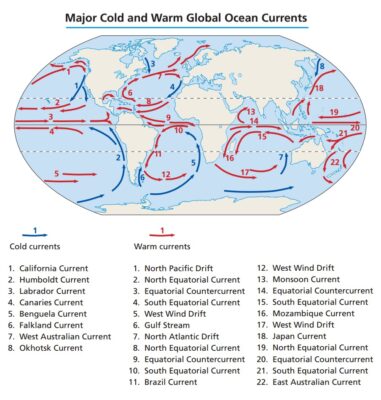- Home
- Prelims
- Mains
- Current Affairs
- Study Materials
- Test Series
Dec 1st, 2021 - Daily Quiz
1. Consider the following islands:
- Mauna Loa
- Galapagos
- Marshall Islands
- Mauritius
- Eastern part of Argentina
- North America
- Siberia
- The rotation of the earth
- The gravitational forces exerted by the Sun
- The gravitational forces exerted by the Moon
- Nitrogen
- Oxygen
- Argon
- Carbon dioxide
- Neon
- Gulf Stream Current - Cold
- Falkland Current - Cold
- Mozambique Current - Warm
The Laurentian Climate or Cool Temperate Eastern Marine Climate has features of both the maritime and continental climates. Laurentian type of climate is found only in two regions and that too only in the northern hemisphere. They are:
North-eastern North America, including eastern Canada, north-east U.S.A., and Newfoundland. This may be referred to as the North American region.
Eastern coastlands of Asia, including eastern Siberia, North China, Manchuria, Korea and northern Japan or the Asiatic region.
It is absent in Southern Hemisphere because only a small section of the southern continents extends south of the of 40°S latitude.
Some of these small sections come under the rain-shadow region of Andes (Patagonia) and hence Westerlies hardly ever reach these regions.
So these regions are subjected to aridity rather than continentiality.
In other regions, the oceanic influence is so profound that neither the continental nor the eastern margin type of climate exists.
3. (d)
Tide are the periodical rise and fall of the sea levels, once or twice a day, caused by the combined effects of the gravitational forces exerted by the sun, the moon and the rotation of the earth or the centrifugal force of the Earth. Hence, the correct answer is (d).
The centrifugal force is the force that acts to counter the balance the gravity. Together, the gravitational pull and the centrifugal force are responsible for creating the two major tidal bulges on the earth. On the side of the earth facing the moon, a tidal bulge occurs while on the opposite side through the gravitational attraction of the moon is less as it is farther away, the centrifugal force causes tidal bulge on the other side.
The ‘tide-generating’ force is the difference between these two forces; i.e. the gravitational attraction of the moon and the centrifugal force.
On the surface of the earth, nearest the moon, pull or the attractive force of the moon is greater than the centrifugal force, and so there is a net force causing a bulge towards the moon. On the opposite side of the earth, the attractive force is less, as it is farther away from the moon, the centrifugal force is dominant. Hence, there is a net force away from the moon. It creates the second bulge away from the moon. On the surface of the earth, the horizontal tide generating forces are more important than the vertical forces in generating the tidal bulges.
4. (b)
Nitrogen-78.08%
Oxygen- 20.95%
Argon- 0.93%
Carbon Dioxide- 0.036%
Neon- 0.002%
5. (d)
Ocean Currents of the World

The Ocean Currents in the northern hemisphere deflect towards their right and in the southern hemisphere deflect towards their left due to the Coriolis force. The only exception to this rule of the flow of ocean water is found in the Indian Ocean, where the direction of current flow changes with the change in the direction of monsoon wind flow. It is noteworthy that the cold currents are lesser in number as compared to the warm or hot current.

|
Name of Current |
Nature of Current |
| North Equatorial Current | Hot or Warm |
| Kuroshio Current | Warm |
| North Pacific Current | Warm |
| Alaskan Current | Warm |
| Counter Equatorial Current | Warm |
| El Nino Current | Warm |
| Tsushima Current | Warm |
| South Equatorial Current | Warm |
| East Australian Current | Warm |
| Humboldt or Peruvian Current | Cold |
| Kuril or Oya shio Current | Cold |
| California Current | Cold |
| Antarctica Current | Cold |
| Okhotsk Current | Cold |
| Florida Current | Warm |
| Gulf Stream | Warm |
| Norwegian Current | Warm |
| Irminger Current | Warm |
| Rannell Current | Warm |
| Antilles Current | Warm |
| Brazilian Current | Warm |
| Labrador Current | Cold |
| Canary Current | Cold |
| Eastern Greenland Current | Cold |
| Benguela Current | Cold |
| Antarctica Current | Cold |
| Falkland Current | Cold |
| Mozambique Current | Warm and Stable |
| Agulhas Current | Warm and Stable |
| South-West Monsoon Current | Warm and unstable |
| North-East Monsoon Current | Cold and unstable |
| Somali Current | Cold and unstable |
| Western Australian Current | Cold and Stable |
| South Indian Ocean Current | Cold |









 Latest News
Latest News
 General Studies
General Studies